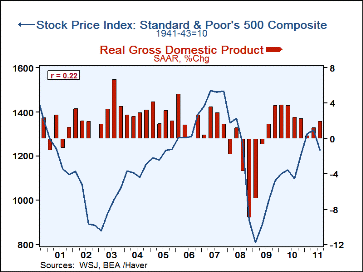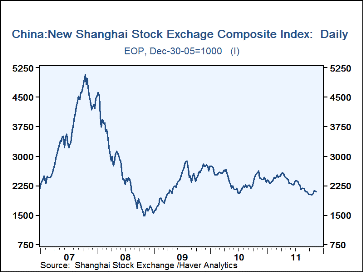 Global| Nov 22 2011
Global| Nov 22 2011China's Stock Market as a Leading Indicator
Summary
The stock market as a predictor of economic trends lost much of its popularity in the United States, at least, after Paul Samuelson quipped decades ago that the stock market had forecast nine out of the last five recessions. In fact [...]
 The stock market as a predictor of economic trends lost much of its popularity in the United
States, at least, after Paul Samuelson quipped decades ago that the stock
market had forecast nine out of the last five recessions.
In fact the correlation coefficient between the stock market and year to
year changes in Real GDP for the United States over the past decade is
only .21, as can be seen in the first chart. The correlation is,
however, higher in other countries, notably China. Over the past five
years the correlation between the Shanghai Stock Exchange Composite and
annual rates of change in China's GDP was .71, as shown in the second
chart. Recently the Financial Times suggested that the Stock
market in China "provides an imperfect yet mightily useful
leading indicator for the domestic economy."
The stock market as a predictor of economic trends lost much of its popularity in the United
States, at least, after Paul Samuelson quipped decades ago that the stock
market had forecast nine out of the last five recessions.
In fact the correlation coefficient between the stock market and year to
year changes in Real GDP for the United States over the past decade is
only .21, as can be seen in the first chart. The correlation is,
however, higher in other countries, notably China. Over the past five
years the correlation between the Shanghai Stock Exchange Composite and
annual rates of change in China's GDP was .71, as shown in the second
chart. Recently the Financial Times suggested that the Stock
market in China "provides an imperfect yet mightily useful
leading indicator for the domestic economy."
The second chart shows the sharp rise as in the stock price as economic growth accelerated and equally sharp fall in the index as the economic growth decelerated. From a daily peak of 5067 on October 18, 2007, the index fell to a low of 1555 on January 2, 2009. The rise since then has been more subdued. The index has never approached the heights reached in 2007 nor has the growth rate. The peak rate of growth in the early period was 14% reached in the first quarter of 2007. The peak in the post 2008 recovery was 11.9% in the first quarter of 2010. (The third chart shows the daily price of the New Shanghai Stock Price Composite index over the past five years so that particular highs and lows can be noted.)
Since November 12, 2010 when the index was at 2629, it has been trending downward. The quarterly growth rate has declined from 9.8% in the fourth quarter of 2010 to 9.1% in the third quarter of 2011. As of November 18, 2011 it was at 2097, suggesting another decline in the rate of growth in the fourth quarter.







